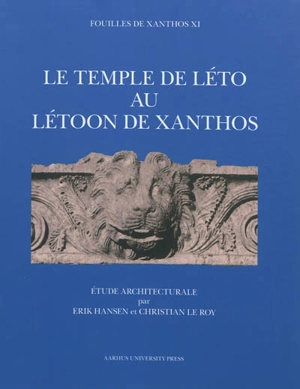
Fouilles de Xanthos. Vol. 11. Le temple de Léto au Létoon de Xanthos
Erik Hansen , Christian Le Roy
Versailles, Lyon 2ᵉ, Lyon 6ᵉ...
Ce que dit l'éditeurL'objet de cette étude est l'architecture et l'histoire du temple de Léto, principal édifice du sanctuaire consacré à cette déesse, près de la cité de Xanthos en Lycie (Turquie). Un premier temple a été construit au début du IVe siècle av. J.-C., sur ordre du dynaste local Arbinas, après consultation de l'oracle de Delphes. Seule l'assise de base de cet édifice était en pierre et a été retrouvée, l'élévation étant en colombage. Face à l'entrée du temple, au Sud, se trouvait la source sacrée qui était sa raison d'être. Ce premier temple a été remplacé, au IIe siècle av. J.-C., très probablement à l'initiative de la Ligue des cités lyciennes, par un édifice plus vaste en pierre. Après plusieurs siècles de prospérité, le temple fut détruit et le site abandonné, mais la ruine n'a jamais été exploitée comme carrière. Lorsque Henri Metzger inaugura la fouille en 1962, on se trouvait dans la situation rare d'un bâtiment totalement ruiné, mais dont subsistaient environ 1000 blocs, soit près de 80 % du total. Leur étude a occupé les campagnes annuelles de 1972 à 1995 et a permis de révéler tous les détails de la construction, des fondations au toit. De plus, un imposant avant-corps, situé au centre de la façade principale, a pu être identifié avec l'autel des sacrifices. Le but de cette publication est de faire entrer dans l'histoire de l'architecture grecque un temple peu connu, qui, tout en gardant son caractère local, présente, pour son époque, une qualité de construction et une finesse de décor qui peuvent être favorablement comparées avec ce que l'on trouve à la même époque en Grèce. The subject of this study is the architecture and history of the main temple of the sanctuary of Leto near the town of Xanthos in Lycia (Turkey). A first temple was built in the early 4th century B.C., by the local dynast Arbinas, after previous consultation of the oracle of Apollo in Delphi. Only the first layer of the walls was built of stone. The upper part was made of adobe and wooden beams. Facing the entrance of the temple, on the south, was the sacred spring, i.e. the original cult-place and the reason for the temple's existence. During the 2nd century B.C., this building was replaced by a larger stone temple, probably built at the initiative of the League of the Lycian cities. The sanctuary flourished during the late Hellenistic and Roman times. In late antiquity, the temple was destroyed and the site deserted, but the ruin was never used as a quarry. Thus, when Henri Metzger initiated the excavations in 1962, one was facing the rare situation of a totally ruined building, of which about 80 % of the blocks were still estant. The study of more than one thousand blocks was completed from 1972 to 1995, and all the building details and refinements were rediscovered. Moreover, an imposing projecting masonry, in the middle of the south front, could be identified with the sacrificial altar. The aim of this publication is to bring into the history of Greek architecture an until now little known temple. While keeping local features, it offers, for its time, building and ornemantation refinements that can be favourably compared with many architectural realizations to be found at the same time in Greece. |
RésuméLe sanctuaire de la déesse Léto, proche de la cité de Xanthos, en Lycie, a été fouillé entre 1962 et 1995. Cette étude en décrit l'architecture et l'histoire. Après un premier temple élevé au IVe siècle av. J.-C., un second temple a été édifié au IIe siècle av. J.-C., très probablement à l'initiative de la Ligue des cités lyciennes. Qualité de la construction et finesse du décor le caractérisent. ©Electre 2024 |
Caractéristiques Auteur(s) Éditeur(s) Date de parution
22 mai 2012
Rayon
Histoire ancienne, préhistoire
EAN
9788771240252
Reliure
Coffret
Dimensions
27.0
cm x
21.0
cm x
cm
|





